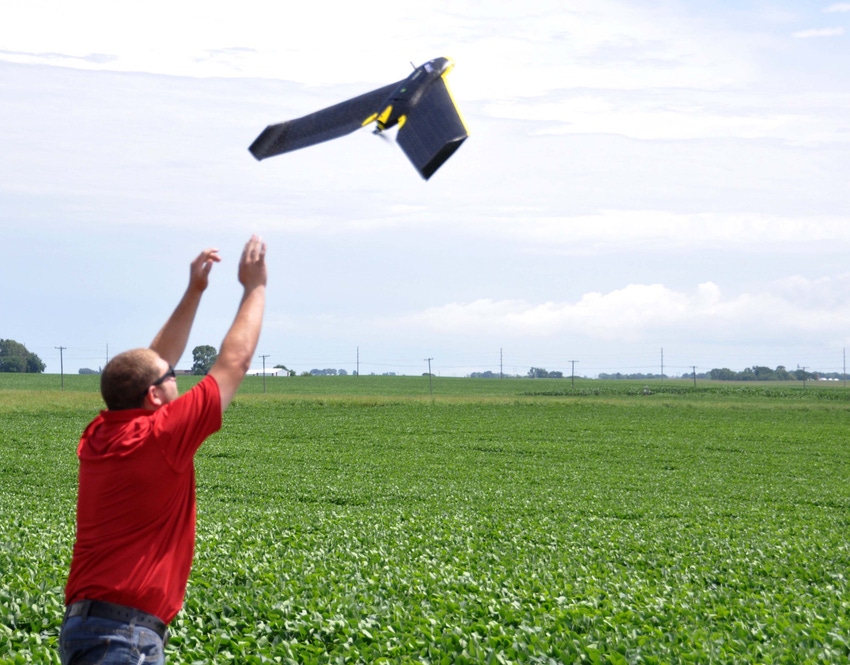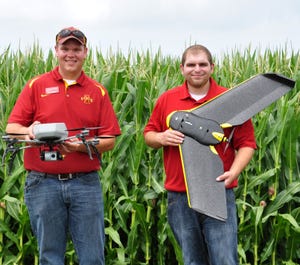December 14, 2016

THINK DIFFERENT
Before you buy a UAV, think about what you want it for. Drones are great for an immediate elevated look at anything you can see with your eyes, like hail damage, nitrogen patterns, and water erosion. But if you want whole field maps, commercial flights that deliver geo-referenced images are more cost-effective.
------------

undefined
Ryan Bergman and Zach Vanderleest have piloted a quadcopter and a fixed wing UAV for the past two years. Among other things, they’ve learned a quadcopter can offer an immediate, high view of a crop you can’t see well from the ground. “If you want a better idea of crop damage from hail or high winds that you can’t see from the ground, and you want to see it the day it happens, a quadcopter can do that for you,” Bergman says. “But while a quadcopter gives you that added perspective, many models can’t produce a geo-referenced map. You get pictures, not stitched and geo-referenced maps.”So while these two Iowa State University agricultural biosystems engineers get photos of ISU research plots with the drones, they also order commercial imagery from low-flying Cessna’s for maps. “We can get aerial imagery that’s stitched together for $2 an acre. That’s a price point that adds value to management decisions,” Vanderleest says.
Learning from experience
Bergman and Vanderleest say they’ve learned first-hand that:
Legal issues about flying a UAV are not always clear or easy to understand. Fly legally and safely 100% of the time—improper use of a UAV can lead to fines and lawsuits that could bring negative publicity to the ag community. You may want to consult a lawyer and your insurance agent before purchasing one for your farm. Know Before You Fly (http://knowbeforeyoufly.org/) is a great resource on the legal aspects of owning a UAV.
Having a second person on-hand while flying is both required by the current regulations and a good idea to help keep track of the UAV and assist with other things while flying. A UAV two hundred feet in the air is easy to lose track of when you are trying to watch the ground station and the UAV simultaneously.
There is a learning curve. You won’t likely pull a UAV out of the box and be making management decisions from it the same day. The first time you fly it, make sure you are in a wide open area.
You’ll need to experiment with your UAV. Try different settings such as flight altitude, camera types & settings, flight path over the field, and time of day just to name a few.
The battery never lasts long enough. Purchase multiple batteries and charge them often. This is especially true for quad copters. Position your ground station to make sure you can always get the UAV back home once the battery starts to drain.
Correct image processing takes time and the right computer (especially for a fixed wing UAV). Your old college laptop or the family computer from the local department store likely isn’t going to give you the processing power you want.
Your UAV will crash; it’s inevitable. Have spare parts on hand so it can be repaired quickly to resume flying.
Flying a UAV takes time. Much more than you think. Whether it’s a quad copter or fixed wing, plan for setup time, flying time, packing up from a flight, and finally processing the images taken during flight.
While UAVs are great for collecting some information fast, there are other sources for imagery (contracted flights and satellite imagery) that are more economical and take some of the headache out of using a UAV.
Use caution when comparing images. Factors such as lighting and other atmospheric conditions, hybrids, soil moisture, time of day, and altitude can affect how the plants reflect light. Ground truth what you think you are seeing in an image to make sure it actually exists and that you determine the proper cause of it.
________________________________________________________________________________________________________________________________________________________
Where to spend your first $5/acre on aerial imagery?
ISU agricultural engineer Matt Darr would spend his first money on aerial imagery to look at corn at the V10 stage. Hands down. “There’s a ton of benefits to looking at corn at that early stage,” Darr says. “You can see tire tracks, residue patterns, soil moisture, planter problems, and other things. There’s enough plant growth at that time to think quality control in a number of areas.”
For his money, Darr would order commercially flown NDVI images of corn at the V10 stage. “We use this imagery as part of a continuous improvement process,” says Darr, referring to crop color changes so slight they show soil compaction differences and other machinery driven crop variability. “The imagery helps you continually improve your production practices to achieve consistent corn.”
Pros, cons and cost comparison of drone types
| Quadcopter | Fixed wing | satellite | Low flight planes |
Pros | Instantaneous feedback | Flight is usually automated | Low cost | Provides multiple geo-referenced images |
| Simple to use | Provides a geo-referenced image | Manageable data size | Generally no processing required by grower |
|
|
| Ability to get historical imagery | More senors available that are cost prohibitive for a grower to own |
Cons | Very limited battery life | Data files are large and can be difficult to manage | Generally lower resolution than other options | Once ordered, usually takes a couple of days before flight happens |
|
| No instantaneous feedback |
|
|
Costs | $200-$10,000 | $10,000+ | $0.20/acre+ | $1-$2.50/acre |
About the Author(s)
You May Also Like




